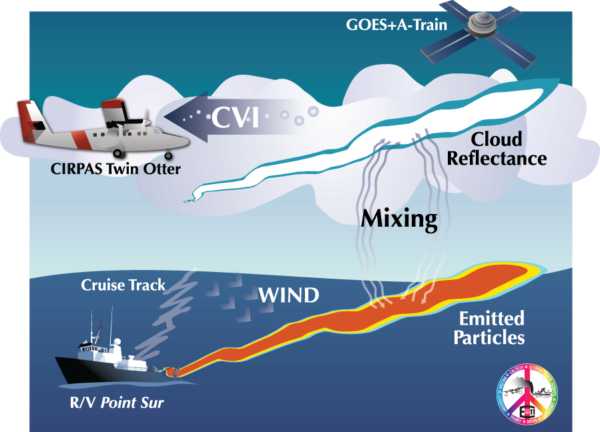Marine background and plume aerosol measurements off the coast of California in July-August 2011 during E-PEACE (Eastern Pacific Emitted Aerosol Cloud Experiment)
Marine background and plume aerosol measurements off the coast of California in July-August 2011 during E-PEACE (Eastern Pacific Emitted Aerosol Cloud Experiment)
About this collection
- Extent
-
1 digital object.
- Cite This Work
-
Sanchez, Kevin J.; Russell, Lynn M.; Frossard, Amanda A.; Modini, Robin L.; Ahlm, Lars; Muelmenstaedt, Johannes; Haflidi, Jonsson; Roberts, Greg C.; Seinfeld, John H.; Sorooshian, Armin (2017). Marine background and plume aerosol measurements off the coast of California in July-August 2011 during E-PEACE (Eastern Pacific Emitted Aerosol Cloud Experiment). UC San Diego Library Digital Collections. https://doi.org/10.6075/J0D798MC
- Creation Date
- 2011-07-12 to 2011-08-18
- Date Issued
- 2017
- Principal Investigator
- Researchers
- Methods
-
E-PEACE included a 12-day research cruise on the R/V Point Sur (12 to 23 July 2011) and 30 research flights on the Center for Interdisciplinary Remotely-Piloted Aircraft Studies (CIRPAS) Twin Otter aircraft (8 July to 18 August). Both the ship and aircraft were equipped with an array of instruments to provide detailed meteorological and aerosol measurements [Russell et al., 2013]. Measurements are included from cargo ship exhaust and the release of organic smoke from two U.S. Army-issued smoke generators to produce concentrated plumes of particles consisting of vaporized and condensed paraffin oil [Russell et al., 2013; Wonaschuetz et al., 2013].
A vertical inlet, shielded from sea spray, on the forward deck of the R/V Point Sur was used to sample air. Aerosols were dried in diffusion driers before delivery to instruments. A Scanning Electrical Mobility Sizer (SEMS, Model 138, 2002, BMI, Hayward, CA) was used to measure the number size distribution of submicrometer (0.01 - 0.9 μm diameter) particles. Humidified Tandem Differential Mobility Analyzer (HTDMA) measured, the size-resolved hygroscopic growth factors of ambient aerosol particles (i.e., the ratio of a humidified diameter at a specific relative humidity to the dry diameter). Refer to [Wonaschuetz et al., 2013] for more information. Supermicrometer particle size distributions were measured using an Aerodynamic Particle Sizer (APS 3321, TSI Inc., St. Paul, MN, size range 0.5–20 μm) and an Optical Particle Sizer (OPS 3330, TSI Inc., St. Paul, MN, size range 0.3–10 μm). The total number concentration of aerosol particles was tracked with a condensation particle counter (CPC 3010, TSI Inc., St. Paul, MN) to monitor contamination from the R/V Point Sur stack and from nearby ships. Submicrometer particles were separated from supermicrometer particles with a cyclone (sharp cut cyclone SCC 2.229, BGI Inc. US), then analyzed with a high-resolution time-of-flight aerosol mass spectrometer (HR-ToF-AMS, Aerodyne Research Inc., Billerica, MA) to measure non-refractory inorganic (sulfate, ammonium, nitrate, chloride) and organic components [DeCarlo et al., 2006]. The submicrometer particles were also collected on 37mm Teflon filters and analyzed using Fourier transform infrared (FTIR) spectroscopy (Bruker Tensor 27 spectrometer, Bruker, Billerica, MA) to quantify the organic functional group composition [Frossard et al., 2014; Takahama et al., 2013; Russell et al., 2009; Maria et al. 2003]. Particles were also collected on Millipore Fluoropore filters where the substrates were extracted and analyzed using ion chromatography (IC) to quantify sodium and chloride ion concentration. For the HR-ToF-AMS, a collection efficiency of 1 and a detection limit of 0.01 µg m-3 were applied [Wonaschuetz et al., 2013; Modini et al., 2015]. Elemental carbon was measured with a single-particle soot photometer (SP2, DMT, Boulder, CO), which has a particle size range of 80-300 nm; elemental carbon concentrations were negligible during E-PEACE and are not included. Plumes were considered to be a second (internally mixed) aerosol population separate from the background populations [Modini et al., 2015]. A ceilometer (Model CL31, Vaisala) was used to measure cloud base height on Scripps Pier.
On the CIRPAS Twin Otter, similar instruments as those on the R/V Point Sur were used to measure dried aerosol concentrations and properties at various heights. Cloud droplet residuals were sampled with a counterflow virtual impactor (CVI) inlet. Details of this inlet are provided by Shingler et al. [2012]. Scanning differential mobility analyzers (models 3081 and 3010, TSI, Inc., St. Paul, MN), with time resolutions of 110 s, and a passive cavity aerosol spectrometer probe (PCASP 0.1–10 µm, PMS Inc., Boulder, Co) were used to measure aerosol size distributions. Multiple CPCs (models 3010 and 3025, TSI, Inc., St. Paul, MN) measured total aerosol concentration. A compact time-of-flight aerosol mass spectrometer (C-ToF-AMS, Aerodyne Research Inc., Billerica, MA) measured inorganic and organic composition in mass spectrum mode. The C-ToF-AMS had a time resolution of 8–12 s, a size range of 60–600 nm, and a collection efficiency of 0.53 [Coggon et al., 2012]. A CCN counter operating in scanning flow CCN analysis mode [Moore and Nenes, 2009] was used to estimate the maximum supersaturation by comparing the measured CDNC to the CCN at supersaturations between 0.1% and 0.8%. A cloud aerosol spectrometer (CAS) and cloud droplet probe (CDP, DMT, Boulder, CO, [Lance et al., 2010]) measured in-cloud droplet number distributions. - Funding
-
NSF AGS-1013423, NSF AGS-1360645, NSF AGS-1008848, DOE DE-SC0006679, ONR grants N00014-11-1-0783, N00014-10-1- 0200, and N00014-10-1-0811
- Geographics
- Topics
Formats
View formats within this collection
- Identifier
- Related Resources
- Sanchez, K. J., et al. (2016), Meteorological and aerosol effects on marine cloud microphysical properties, J. Geophys. Res. Atmos., 121, 4142–4161. https://doi.org/10.1002/2015JD024595
- Shingler, T., E. Crosbie, A. Ortega, M. Shiraiwa, A. Zuend, A. Beyersdorf, L. Ziemba, B. Anderson, L. Thornhill, A. E. Perring, et al. (2016), Airborne characterization of subsaturated aerosol hygroscopicity and dry refractive index from the surface to 6.5 km during the SEAC4RS campaign, J. Geophys. Res. Atmos., 121, 4188–4210. https://doi.org/10.1002/2015JD024498
Primary associated publication
Reference
 Library Digital Collections
Library Digital Collections
